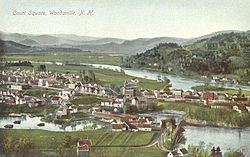Country United States Time zone Eastern (EST) (UTC-5) Elevation 139 m Population 1,126 (2010) | ZIP code 03785 Area 234 ha Area code Area code 603 | |
 | ||
Restaurants Saltwater Bar & Bistro, The Little Grille's Comida, New Century, Shiloh's Restaurant, Dunkin' Donuts | ||
Woodsville is a census-designated place (CDP) in the town of Haverhill in Grafton County, New Hampshire, U.S., along the Connecticut River at the mouth of the Ammonoosuc River. The population was 1,126 at the 2010 census. Although North Haverhill is now the county seat of Grafton County, the village of Woodsville has traditionally been considered the county seat, as the county courthouse was originally located there. The county buildings are now located halfway between Woodsville and the village of North Haverhill to the south.
Contents
- Map of Woodsville Haverhill NH 03785 USA
- History
- Geography
- Demographics
- Notable people
- In popular culture
- References
Map of Woodsville, Haverhill, NH 03785, USA
History
Woodsville was named for John L. Woods, a figure in its early development. He arrived from Wells River, Vermont, a village across the Connecticut River narrows in Newbury, and in 1829 purchased a sawmill which had been operating on the Ammonoosuc River since 1811. He manufactured pine lumber, and opened a store in his house. Spring snowmelt carried log drives down the Connecticut and Ammonoosuc rivers. A log boom was built across the Connecticut River to Wells River to hold the logs briefly for sorting. Logs not destined for Woods' mill were released gradually to avoid jams in the Ox Bow meadow downstream. Log drivers detailed to work at the boom enjoyed Woodsville's saloons and red-light district.
The Boston, Concord & Montreal Railroad opened at Woodsville in 1853 and built its division offices and a branch repair shop. It replaced the original 1805 bridge between the states with a two-level span, featuring a toll highway below and railroad tracks on the roof. The village boomed into an important railway town and junction, endowed with fine examples of Victorian architecture. It also became a center for legal affairs. The log drives were stopped after 1915, when pleasure boat owners complained about the hazards to navigation. In 1889, the Grafton County Court moved from Haverhill Corner to Woodsville, where it remained until moving halfway to North Haverhill in 1972.
Geography
According to the United States Census Bureau, the Woodsville CDP has a total area of 0.90 square miles (2.34 km2), of which 0.88 square miles (2.28 km2) is land and 0.019 square miles (0.05 km2), or 2.23%, is water. Woodsville is drained by the Ammonoosuc River, which reaches its confluence with the Connecticut River in the village.
Woodsville is crossed by U.S. Route 302, and state routes 10 and 135.
Woodsville serves as the commercial center for the town of Haverhill and the surrounding communities, including several just to the west in Vermont. Many of the town's commercial businesses, including supermarkets, sit-down and fast-food restaurants, and banks, are located near the junction of US 302 and NH 10. Cottage Hospital, a critical-access hospital serving the area, is also located in Woodsville.
Demographics
At the 2010 census, there were 1,126 people, 482 households and 293 families residing in the CDP. The population density was 1,277 per square mile (493.2/km²). There were 558 housing units at an average density of 634.1 per square mile (244.7/km²). The racial makeup of the CDP was 96.5% White, 0.2% African American, 0.5% Native American, 1.5% Asian, 0.1% Pacific Islander, 0.3% some other race, and 0.9% from two or more races. Hispanic or Latino of any race were 1.26% of the population.
There were 482 households of which 30.7% had children under the age of 18 living with them, 41.1% were headed by married couples living together, 15.4% had a female householder with no husband present, and 39.2% were non-families. 31.7% of all households were made up of individuals, and 9.8% were someone living alone who was 65 years of age or older. The average household size was 2.34, and the average family size was 2.87.
23.9% of the population were under the age of 18, 9.4% from 18 to 24, 26.3% from 25 to 44, 28.1% from 45 to 64, and 12.3% were 65 years of age or older. The median age was 38.0 years. For every 100 females there were 92.5 males. For every 100 females age 18 and over, there were 87.5 males.
For the period 2007-11, the estimated median household income was $33,295, and the median family income was $43,984. Male full-time workers had a median income of $42,014 compared with $26,985 for females. The per capita income for the CDP was $14,744. About 19.7% of families and 23.4% of the population were below the poverty line, including 44.4% of those under age 18 and 5.9% of those age 65 or over.
Notable people
In popular culture
In The Stand, by Stephen King, Woodsville is mentioned as the home of Glendon Pequod Bateman, a major character in the novel. He was an associate professor of sociology at the fictional Woodsville Community College when the Superflu hit, and claimed that Woodsville was famous for its college and "five gas stations".
